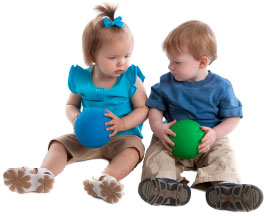Social and Emotional Development
 Social and emotional development encompasses young children’s evolving capacity to form close and positive adult and peer relationships;
Social and emotional development encompasses young children’s evolving capacity to form close and positive adult and peer relationships;
to actively explore and act on the environment in the process of learning about the world around them; and express a full range of emotions in socially and culturally appropriate ways. These skills, developed in early childhood, are essential for lifelong learning and positive adaptation. A child’s temperament (traits that are biologically based and that remain consistent over time) plays a significant role in development and should be carefully considered when applying social and emotional standards. Healthy social and emotional development benefits from consistent, positive interactions with educators, parents/primary caregivers, and other familiar adults who appreciate each child’s individual temperament. This appreciation is key to promoting positive self-esteem, confidence, and trust in relationships. The components within this domain address children’s relationships with others—adults and other children—their personal identity and self-confidence, and their ability to regulate their emotions and behavior.
All children, including multilingual learners and children with disabilities may demonstrate alternate ways of meeting social and emotional goals; for example, children with visual impairments and/or children from other cultures may vary in direct eye contact and demonstrate their interest in and need for human contact in other ways, such as through acute listening and touch. Children with disabilities may initiate play through use of subtle cues, at a different pace or with a different degree of accomplishment. In general, the presence of a disability may cause a child to demonstrate alternate ways of meeting social and emotional goals. The goals for all children are the same, even though the path and the pace toward realizing the goals may be different. When observing how children respond in relationships, teachers must consider appropriate adaptations and modifications, as necessary. Principles of universal design for learning (UDL) offer the least restrictive and most inclusive approach to developing environments and curricula that best support the social and emotional development as well as the cultural and experiential backgrounds of all children.
Remember:
Healthy social and emotional development is aligned with cross-domain learning and development. Children’s development of a Self-Awareness and Competence, for example, is strongly linked to their learning in Social Studies (e.g., Civics & Government, History). Their development of emotional recognition and regulation contributes to their development of cognitive skills (e.g., Attention and Inhibitory Control) and their abilities to persist at learning activities in language, literacy, mathematics, and science. Successful experiences in the content areas also positively contribute to children’s social/emotional development. While this domain represents general expectations for social and emotional development, each child will reach the individual standards at their own pace and in their own way.
